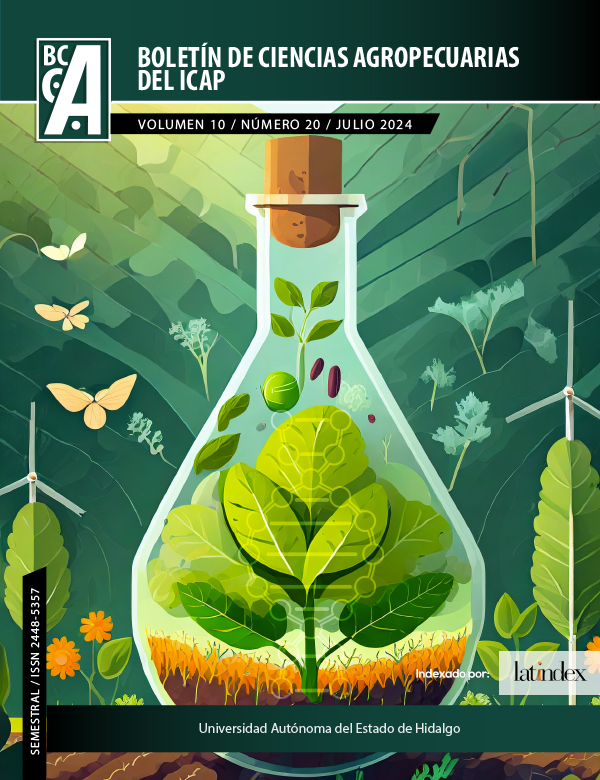Determination of the physicochemical properties of wild tomato native from Veracruz, Mexico
Abstract
Native tomatoes have distinctive physicochemical properties, thus achieving greater acceptance among consumers; however, these properties can change according to the region where they are produced. Therefore, the objective of this work was to evaluate the physicochemical properties such as total soluble solids (TSS), pH, titratable acidity (TA), ripening index (RI), flavor index (FI), and color in four indices of maturity (green-90%, red-30 / green-60%, red-60 / green-30%, red-90%) of native tomato fruits that are produced in the northern region of the state of Veracruz. It was found that the TSS varied from 4.63 to 6.53 °Bx, while the TA was reduced from 2.07 to 0.80% citric acid. The RI obtained was 8.28, which is related to the increase in TSS and the reduction in TA, while the tomatoes were classified as tasty according to the FI. According to the color they varied from shades of light green to dark red. In general, changes in the physicochemical properties of the fruits were observed during ripening, reaching adequate properties at ripening that reflect their high acceptability by consumers.
Downloads
References
Hernández-Fuentes A D, Arroyo-Aguilar J E, Gutiérrez-Tlahque J, Santiago-Saenz Y O, Quintero-Lira A, Fuentes-Reyes M, López-Palestina C U. Application of Cu Nanoparticles in Chitosan-PVA Hydrogels in a Native Tomato Genotype: Evaluation of the Postharvest Behavior of the Physicochemical and Bioactive Components of the Fruits. Food Bioprocess Tech. 2023, doi: 10.1007/s11947-023-03044-x.
López-Vargas E R, Ortega-Ortíz, H, Cadenas-Pliego G, de Alba Romenus K, Cabrera de la Fuente, M, Benavides-Mendoza A, Juárez-Maldonado A. Foliar Application of Copper Nanoparticles Increases the Fruit Quality and the Content of Bioactive Compounds in Tomatoes, Appl. Sci. 2018; 8 (7): 1020, doi: 10.3390/app8071020.
López-Palestina C U, Aguirre-Mancilla C L, Raya-Pérez J C, Ramírez-Pimentel J G, Santiago-Saenz Y O, Gutiérrez-Tlahque J, Hernández-Fuentes A D. Encapsulation of tomato juice by freeze-drying: physicochemical and antioxidant characterization and stability. Acta Agrícola y Pecu. 2021; 7(1): 1-14, doi: 10.30973/aap/2021.7.0071000.
Gutiérrez Tlahque J, Santiago Sáenz Y O, Hernández Fuentes A D, Pinedo Espinoza J M, López Buenabad G, López Palestina C U. Influencia de los métodos de cocción sobre la actividad antioxidante y compuestos bioactivos de tomate (Solanum lycopersicum L.). Nov. Sci. 2019; 11(22): 53–68, doi: 10.21640/ns.v11i22.1685.
Crisanto-Juárez A U, Vera-Guzmán A M, Chávez-Servia J L, Carrillo-Rodríguez J C. Calidad de frutos de tomates silvestres (Lycopersicon esculentum var. cerasiforme Dunal) de Oaxaca, México. Rev. Fitotec. Mex. 2010, 33: 7–13.
Juárez-López P, Castro-Brindis R, Colinas-León T, Ramírez-Vallejo P, Sandoval-Villa, M, Reed D W, King S. Evaluación de calidad de frutos de siete genotipos nativos de jitomate (Lycopersicon esculentum var. cerasiforme). Rev. Chapingo. Ser. Hortic. 2009, 15: 5–9.
Pérez-Díaz F, Arévalo-Galarza M de L, Pérez-Flores L J, Lobato-Ortiz R, Ramírez-Guzmán M E. Crecimiento y características postcosecha de frutos de genotipos nativos de tomate (Solanum lycopersicum L.),” Rev. Fitotec. Mex. 2020, 43(1): 89–99, doi: 10.35196/rfm.2020.1.89.
Méndez I, Vera G, Chávez S, Carrillo R. Quality of fruits in mexican tomato (Lycopersicon esculentum mill.) landraces. Vitae, 2011, 18 (1): 26–32.
AOAC – Association of Official Analytical Chemists, Official Methods of Analysis. 1995.
Hernández Suárez M, Rodríguez Rodríguez E M, Díaz Romero C. Chemical composition of tomato (Lycopersicon esculentum) from Tenerife, the Canary Islands, Food Chem. 2008, 106(3): 1046–1056, doi: 10.1016/j.foodchem.2007.07.025.
Meza S L, Egea I, Massaretto I L, Morales B, Purgatto E, Egea-Fernández J M, Flores F B. Traditional Tomato Varieties Improve Fruit Quality Without Affecting Fruit Yield Under Moderate Salt Stress. Front. Plant Sci. 2020, 11: 587754, doi: 10.3389/fpls.2020.587754.
Xiao H, Piovesan A, Pols S, Verboven P, Nicolaï B. Microstructural changes enhance oxygen transport in tomato (Solanum lycopersicum) fruit during maturation and ripening. New Phytol. 2021, 232(5): 2043–2056, doi: 10.1111/nph.17712.
Balate C A, Souza D C, de, Silva L F L, Resende L V, de Freitas S T, Guerra T S. Abscisic acid on the quality of tomato fruits. Sci. Agrar. Parana, 2020, 1(1): 38–42, doi:10.18188/sap.v19i1.22876.
.
Copyright (c) 2024 Alma Delia Hernández-Fuentes , Aurora Quintero-Lira, Thania Alejandra Urrutia-Hernández, Javier Piloni-Martini, Irma Morales-Rodríguez, César Uriel López-Palestina

This work is licensed under a Creative Commons Attribution-NonCommercial-NoDerivatives 4.0 International License.









